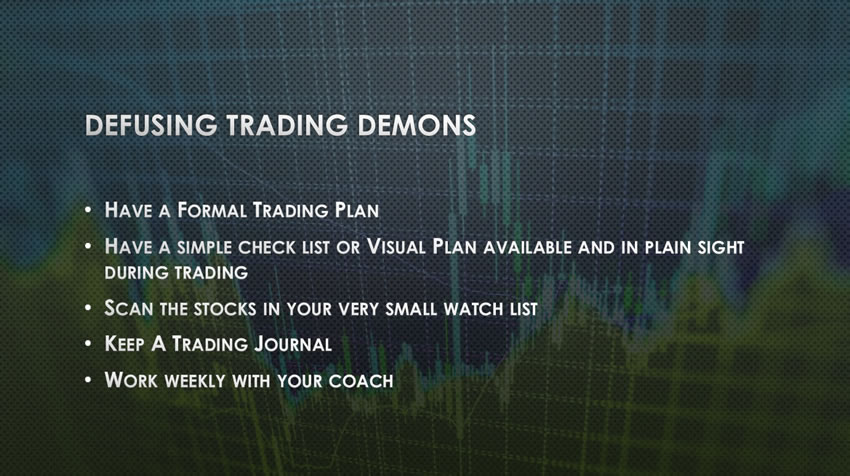In our last blog, we discussed the various trading demons that play on our human emotions. This time we are going to focus on diffusing those trading demons by using our best tools that we have to combat them: Our Trading Plan and Good Trading Practices.
- Have a formal training plan.
When asked, most people think they have a trading plan. They also think that they can keep this plan in their head without writing it down. However, these are the two key elements that make a trading plan, A Formal Trading Plan. The key to writing a successful trading plan is to think about how you intend to make money from the financial markets. What process or methodology will you have that will make your trading successful and profitable when most others fail? - Have a simple one page visible trading plan summary in plain sight during the trading day.
The reason for this is that a full, formal trading plan is complex and has too many details. While trading, you only need the key points to keep you focused during the day. You do not need to see all the details as you probably know them already, but need to be reminded of them while in the trading environment. - Scan the stocks in your small watch list (trading universe).
Get to know the stocks that you trade; we call this your trading universe. These are stocks that you are familiar with, and you look at to do your technical analysis on a daily and weekly basis. Be sure to mark up your charts with your support and resistance levels and study them closely. - Keep a trading journal
The idea behind having a trading journal is simple. By reviewing your trades and marking up your charts you are forced to learn from your mistakes. You are programming your brain to react differently when exposed to the same set of circumstances and training your brain to react better when exposed to other trading variables in the future. Repetition and review are extremely important to the individual human learning process. - Have a trading coach and work with them weekly
Once you’re keeping a trading journal, it’s helpful to review it with somebody who has more experience in the field. A trading coach should be somebody who has more market experience than you do and can review your trades with you on a weekly or biweekly basis. This is also part of the human programming process that teaches us to trade better when faced with similar market situations in the future.
- Start trading small so there’s no reason to break the rules.
By trading small, we remove some of the emotional attachments that we all have to our money. This makes trading more like a game. When we trade and our own money is on the line, our emotional attachments pull on us. This is not because trading is different from any other game, but because in trading, our hard earned money is on the line in the activity. We need to get used to trading small in the beginning, and then only increase our trading size with success. - Judge your trading by how well you follow the rules, not by your P/L.
This is a further re-enforcement meant of the detachment of our trading from our lifelong relationship with money. Our personal relationship with money starts from an early age. This relationship is complex and tied in with all kinds of emotions. By focusing on the rules and how well we follow them, we elevate the importance of our plan and discipline over monetary gain. By doing this, we give emphasis to consistency rather than temporary short term gains, which may or may not be replicable. - Keep a log of your trades and mark up your trading charts.
How does this differ from keeping a trading journal? This is actually a part of your trading journal as you keep a log of your charts as a visual record of your trading results. Generally, we trade off of charts and by marking them, we make a mental recording of the thoughts and emotions we had while we were in the trade. By making this mental record, we can start to focus on adjusting our reactions to those thoughts and emotions when faced with similar situations in the future. - Study your trades.
After you create the marked up chart, let the day pass and review your prior day’s trades. By letting a day pass, you are clearing your head from the previous day’s emotions. You can then look at your prior trades from your visual record (your marked up chart).You should question and write down:
1. What did I do right?
2. What did I do wrong?
3. What can I do better?By asking yourself these three questions, you are taking an important step forward in reprogramming your brain to react differently to the same situation when faced with a future trading situation similar to this one.
- Identify your best trading tactic.
During the review process of your trades, it will become obvious that one of your trading tactics is your best. Meaning, it makes you the most money and you understand it and follow the rules better while applying this tactic. You should focus on this strategy as your primary trading maneuver. This will help finance the rest of your trading education. Become a specialist in this tactic before moving on to experiment with other trading tactics. When something works, keep doing it.
- Meet and discuss your trading with your coach.
Meetings with your Trading Coach should not only focus on reviewing your Trading Journal, but should be regularly scheduled and cover all aspects of your trading plan. - Eliminate as many trading variables in the pre and post market scans.
Try to do as much of the work as possible before the market opens. The following is a list of what you can prepare for in the pre-market.- Make a long list.
- Make a short list.
- Make a gap up list.
- Make a gap down list.
- Make a list of stocks that were mentioned in the news today.
- Have a running list of stocks that are in uptrends on the daily.
- Have a running list of stocks that are in downtrends on the daily.
By making these lists, you do not have to go searching for ideas during the trading day. Updating these lists should take no more than 30 minutes to an hour.
- Have a visual trading plan in plain sight during trading and a pre-trade checklist.
Another step in the right direction towards keeping your trading plan is to have a visual trading plan always in plain sight during your trading day. Print it out on one sheet of paper, and tape it to the wall near your trading station. If you are a “trade from anywhere” kind of person; print it out, keep it in plastic and keep it on the table in front of you. This visual trading plan should include a pre-trade checklist. Over time, you will follow the steps of your checklist without even having to look at the visual trading plan, as you will be programmed only to take a trade when it meets your criteria for entry.
We hope you found this journey into overcoming trading demons helpful, but most of all we hope that you apply the quick fixes that are provided in this blog to your trading. If you do apply them to your trading and stick with them, they will profoundly improve your trading methodology. With an improvement in methodology, improved trading results will come.Trade well and if you are interested in coaching, please click here for coaching information.
Written by Michael DiGioia, Director of Education
Mike is available for One-on-One Coaching. Learn More







